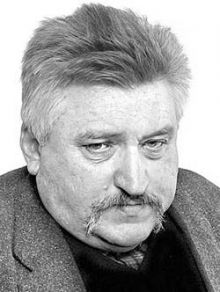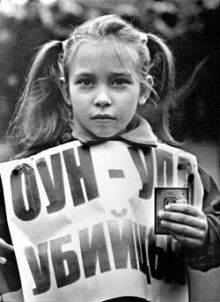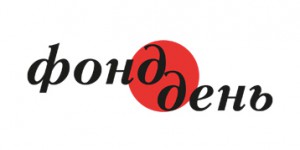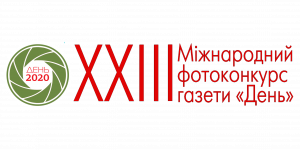In recent days Russia’s top-ranking politicians have been making strident statements to the effect that Ukrainians have an “incorrect” understanding of their own history. These statements require a closer look at their arguments.
These Russian political figures believe that the mean reason for their blatant interference in their neighbor’s internal affairs is the existence of so-called common history.
Unfortunately, these individuals and all the Kremlin historians, analysts, and politicians offer no further explanations of the notion of “common” history. However, the political message is clear: Ukrainians have no right to independently assess events from their past because this past does not belong to them — at least it does not belong solely to them. In other words, Ukrainians allegedly “share” their history with someone else, and every time that they issue any statements about their history they must ask their fellow shareholder’s permission. Every statement in Ukrainian history textbooks must be coordinated with those that claim to share this history. Such “coordinating” trends existed in the Ukrainian establishment among well known people who occupied the deputy premierships for humanities, but they completely vanished after the “Orange people” came to power, which should be recognized as one of their few real achievements.
A closer look shows that this “common” history is an extraordinarily broad concept and thus loses all pragmatic meaning. For a number of centuries nearly all the nations of Western Europe were part of the Roman Empire and later of the so-called Holy Roman Empire of the German Nation. But for some reason the capital of today’s Italy does not dictate to Spaniards how to relate events from their past. The Czech Republic was once part of the Austrian Empire, yet you cannot hear shouting from Vienna about how the Czechs should interpret their life under the scepter of the Austrian monarchs.
Until 1947 Great Britain had a “common” history with India, as France did with Algeria until the early 1960s, yet neither country tells its former colonies how to interpret their history, probably because all plans for restoring them were abandoned long ago. Moscow also had a “common” history with Hungary in 1956 and with Czechoslovakia in 1968, very much so. Perhaps these countries are also misinterpreting something and have to be corrected from the tall building on Smolensk Square?
If this “common” history indeed gives Russia the right to lecture Ukraine, perhaps this “common” history gives Ukraine the same right? Not so long ago, on the Kremlin’s highest orders, the remains of General Anton Denikin, the fiercest enemy of Soviet rule and an imperialistic chauvinist, were reburied in Moscow. Today he is a hero of the Russian Federation. Did anyone ask for Ukraine’s opinion? Denikin turned southern Ukraine into a bloodbath, which led to the mass uprising led by Nestor Makhno. Denikin’s General Slashchev built gallows all over the Crimea, but that’s OK. Russia deals with its history — which in similar cases suddenly ceases to be common with anyone — the way it pleases, without asking or listening to anyone’s opinion.
The remains of the reactionary philosopher Ivan Ilyin were reburied with equal pomp. Even his fellow White Guard emigre Roman Gul reproached him for his servile attitude to Adolf Hitler and his caveman’s anti-Semitism. Here again Russia did without anyone else’s views and recommendations. Vladimir Putin personally unveiled a memorial plaque to Yurii Andropov on a wall of the FSB building on the Lubianka, the very same Andropov who founded psychiatric torture chambers for dissidents and on whose watch as chairman of the KGB the Ukrainian intelligentsia was subjected to severe purges. Naturally, no one asked Ukraine’s opinion, or Estonia’s.
However, the main bolts of thunder and lightning are being cast from Moscow’s Olympus in the direction of the unhurried and contradictory process that is beginning to gain momentum in Ukraine: the process of the official recognition of organizations and individuals who fought for Ukraine’s independence, something that the Kremlin finds especially loathsome. After all, the former metropolis’s reaction is understandable. Moreover, it is similar to the reactions of other metropolises. It is hardly likely that George Washington would have remained in the British Crown’s good books for long, just as it is unlikely that the people known as the Libertadores (Liberators) in Latin America (Simon Bolivar, Jose de San Martin, Miguel Hidalgo, Antonio Jose de Sucre, Francisco de Miranda, and others) enjoyed the sympathies of Madrid for many years. Only 17 years have passed since Ukraine was part of Russia/the USSR. Needless to say, such zealots of “common” history are especially irked by such “common” (?) organizations as the OUN and UPA.
These organizations were the ones that often served as a political lightning rod for all those for whom the independence of Ukraine was a thorn in their side. Whereas publicly opposing Ukraine’s sovereignty is not very politic and such actions may be misinterpreted, it is very convenient to lash out at those who fought for this very independence and sovereignty. Such people claim: ‘I am not so much against Ukraine as against Ukrainian nationalists.’ One is strongly reminded of the situation in the USSR during the Six-Day War in the Middle East, when all Soviet anti-Semites suddenly turned into “dedicated fighters” against Zionism.
Non-recognition of the OUN and UPA was very convenient for those who hoped that Ukraine would return to the “bosom,” inasmuch as this non-recognition of the most consistent national-state force cast a shadow on Ukraine’s sovereignty and called into question the legitimacy of Ukrainian independence. Indeed, how can independence be recognized as legitimate when the struggle for it is presented as illegitimate and criminal? In addition, recognition of the OUN and UPA is a very serious move that will finally destroy all the hopes of those theoreticians of the strategy of “limited sovereignty,” sovereignty that exists exclusively within the framework allowed by the “main carriers of the common history.” Its agents are trying to convince us that there was something shameful about the Ukrainian national liberation movement, something that should be kept secret and hidden. But this discredits Ukrainian statehood as such.
Hence, the myths about the OUN and UPA’s “atrocities” against the local population, which have been accumulating more than 60 years, although these allegations are beneath criticism from the standpoints of history and logic.
The prominent theoretician and practician of guerrilla warfare Ernesto de la Serna (commonly known as Che Guevara) proved that no guerilla war is possible without mass support from the local population. Will the population support those who are terrorizing it? This is a rhetorical question, especially in regard to the conditions in occupied western Ukraine with its polarized political forces and military formations. Che Guevara proved his main thesis, which is called “from the contrary premise.” When his guerrilla detachment found itself isolated in the Bolivian selva (forest) in 1966- 67, without any support from the population, the rebels were rather quickly surrounded and destroyed by government troops. In contrast, the Ukrainian insurgents fought the 20th century’s most powerful regimes for more than 10 years. Today, most people in western Ukraine are sympathetic to the OUN and UPA; for them these people are still “our boys.”
All reproaches aimed at them give rise to this sacramental question: “And who are the judges?” Those who sympathize with the Stalinist regime and its special services? Who are they to accuse anyone of cruelty? Some humanists they are! It is interesting to note whom our Russian “teachers” of “common” history uphold and condemn. For example, our neighbor was angered by the festivities in Ivano-Frankivsk commemorating the UPA veteran Myroslav Symchych, whose company defeated the punitive units of the same NKVD division that had deported the Crimean Tatars and the highlanders of the Caucasus.
In other words, our opponents objectively defend those who committed crimes against the civilian population of Ukraine and other former Soviet republics and autonomies, and curse those who were saving their people from repressions and fought for the independence of their country. This is precisely the situation.
The statements that attack various figures of the Ukrainian national liberation movement are proof of the profound internal resemblance between the current Russian elite and the Stalinist repressive-punitive system, which today it is experiencing so acutely and emotionally whenever it attacks the opponents of the Stalinist dictatorship. This means that Russia’s ruling stratum is the political and ideological successor of Bolshevik totalitarianism, the most reactionary in all of Russian history.
Even today, Stalinism as a spirit and way of thinking, as a basis for the assessment of historical facts, governs the minds of those who are controlling Russia’s destiny.
Double standards in the assessment of the Russia (Soviet) and Ukrainian past are especially brilliantly revealed in the accusations that the OUN and UPA collaborated with Nazi Germany. However, the fact that the UPA was not an ally of the Wehrmacht is utterly ignored, whereas in 1939-41 the Red Army was, de facto and de jure.
The UPA did not hold any joint parades with the German Wehrmacht, while the Red Army did. There are Soviet film and photo archives from 1939 that show such a parade in Brest, where German and Soviet soldiers are marching together, while the German General Guderian and Soviet Brigade Commander Kryvoshein are inspecting it. Similar joint Red Army and Wehrmacht actions also took place in Kovel and Pinsk.
During its war in the West, Germany received a great deal of assistance from the USSR in the form of strategic materiel, raw materials, fuel, etc. Poland’s defeat was also the doing of both armies. A photo from that period shows Major General Chuikov (the future Soviet marshal and hero of the Battle of Stalingrad) in the company of Wehrmacht officers, pointing to places on a map where joint operations against Poland were to be carried out. An interesting detail: Chuikov is photographed sitting under a large portrait of Joseph Stalin. Viacheslav Molotov dotted the “i’s” when he addressed a session of the Supreme Soviet of the USSR shortly after these events: “Poland, that monstrous child of the Versailles Peace Treaty, has collapsed from the joint blows of German and Soviet troops.”
German foreign ministry archives contain Molotov’s telegrams congratulating the Wehrmacht on seizing Warsaw and Paris. The Soviet Navy secured the passage for the Nazi raider KMS Komet through the North Atlantic route from the Atlantic to the Pacific, where she would very effectively sink British ships. At the time Great Britain was fighting Nazism single-handedly, while Comrade Stalin was raising toasts in the Kremlin to Hitler and Himmler, whom he called the “guarantor of order in Germany,” during Reich Minister Ribbentrop’s visit. In issue no. 11, 2007, of Morskoi sbornik (the official organ of Russian Federation’s Navy) carried an article by S. Kovalev entitled “Basis Nord: Myth or Reality?” (The USSR granted the Germans the use of a U- Boat replenishment base near Murmansk: this act was called Basis Nord-Ed.)
Kovalev convincingly proves that it was a reality. Early in October 1939 the German Navy started using secret bases west of Murmansk. In return for using this secret base on the Kola Peninsula, Germany provided the USSR with military and technological aid. German ships hid there from British vessels and were repaired by Soviet personnel. A large construction project known as Kriegsmarine was launched on the banks of Nerpich’ya Bay, a German naval base that existed until September 1940, when Germany’s naval commander, Grand Admiral Erich Johann Albert Raeder, thanked the Soviet side for allowing the Germans to use it and proceeded to dismantle it.
Some of Russia’s representatives in Kyiv, without bothering about diplomatic protocol, lash out at figures of the Ukrainian national liberation movement, branding them “Nazi hirelings.” Why don’t they refer the same way to Stalin, Molotov, Beria, Zhdanov, Zhukov, Malenkov, Kaganovich, the All- Union Communist Party (Bolshevik), and the Red Army, which were precisely that in 1939- 41, while the Soviet Union was a strategic partner of Nazi Germany?
Are these not double standards? During that period the USSR, together with the Nazis, carried out acts of aggression and annexations of the nations of Europe. Incidentally, Stalin was not overly optimistic about his regime and his associates. The Russian military historian Yurii Rubtsov recently published a book in Moscow, entitled Marshaly Stalina: ot Budionnogo do Bulganina (Stalin’s Marshals: from Budionny to Bulganin). It contains this interesting fact: when Roosevelt, to whom Lavrentii Beria was not introduced at the Yalta Conference, asked who that gentleman was, Stalin seriously replied: “He is our Himmler.”
During the Nuremberg trials the Kremlin was concerned about other things, besides the punishment of Nazi war criminals. As the Russian historian Irina Pavlova writes, “Immediately after the war Stalin ordered the creation of a special body that was referred to differently in various documents: “State Commission on the Nuremberg Trials,” “State Commission for the Organization of the Nuremberg Trials.” This was a top-secret body with special powers and Stalin appointed Andrei Vyshinsky its chairman. Among the commission members were Prosecutor General of the Soviet Union Konstantin Gorshenin, Chairman of the Supreme Court of the USSR Ivan Goliakov, People’s Commissar of Justice Nikolai Rychkov, and Beria’s three closest associaties: his deputies Viktor Abakumov, B. Kobulov, and Vsevolod Merkulov.
The commission’s main task was to prevent all public discussions of any aspects of Soviet-German relations, let alone discussions of the so-called secret protocols that supplement the German-Soviet Non-Aggression Pact (Aug. 23, 1939) and the German-Soviet Friendship Treaty (Sept. 8, 1939). In order to protect the instructions that had been issued to the secret commission during the investigation, a special team of investigators was dispatched to Nuremburg, led by Colonel M. Likhachev, one of Beria’s most ruthless butchers. Stalin was afraid that public opinion in Europe would place him on the same bench as the Nazi war criminals being tried in Nuremberg, and he had serious reasons to fear this. Stalin did his best to prevent the Nuremberg tribunal from discussing the USSR’s role in ending the Second World War. He succeeded in this because his position as a victor allowed him to dictate “conditions.”
The question arises: Why has Kremlin’s collaboration with Hitler in 1939-41 not been condemned in Russia, the Soviet Union’s legal heir and successor? This would be more than logical for a country that is waging such a furious struggle for the purity of the anti-fascist uniform.
What is the problem? Perhaps the whole issue boils down to what the Russian historian and journalist Dmytro Khmelnytsky has written: “Antifascism is defined not simply by a position in the fight; it is a way of thinking, a rejection of fascist- type regimes. In other words, antifascism is a struggle for democracy, not the other way around. The Red Army was Stalinist...” Thus, the thesis about the struggle for democracy instantly disappears.
Meanwhile, efforts are being made to foist on us Stalin and Brezhnev’s concept of the Second World War, proceeding from which we are obliged to assess Ukraine’s history of this period. For over a decade the Russian Federation has been trying to refute the books of Viktor Suvorov (Volodymyr Rizun), which expose facts that were diligently concealed in the USSR. Dozens of press conferences have been held and numerous condemnatory volumes have been published, but there are still no correctives. Indeed, how can one correct what did in fact take place? For example, the famous singer Bulat Okudzhava, who was a war veteran, said in an interview published in Literaturnaia gazeta: “I read Suvorov with interest. I find it difficult to doubt that we were also preparing for a major campaign of aggression; they simply beat us to it, and we had to fight to defend our country.”
Another Soviet writer and war veteran, Yurii Nagibin, writes in his novel Svet v kontse tunelia (Darkness at the End of the Tunnel): “The strategy of our military leaders boiled down to providing German weapons with Russian cannon fodder. Zhukov was simply a butcher. Beneath the blows of the Anglo-American bombers the German defense industry collapsed and the Germans surrendered. Before this happened, two disgusting bloodthirsty and vulgar figures, Hitler and Stalin, were in the proscenium of the battle of nations. Two determined politicians, Churchill and Roosevelt, played up to them in supporting roles. During all that time a nasty trade was going on in blood, in the lives of those who survived; they divided up lands, nations, instituted new borders through human hearts, and all the while smoke was billowing more thickly from the gas chambers. And then it turned out that the confrontation had not been between fascism and the rest of mankind, but between two fascist systems. One fascism was defeated, and another fascism triumphed.”
It is enough to glance at the regimes that the Poles, Czechs, Slovaks, and Hungarians obtained in 1945 (they could also have been brought to France, Italy, and Belgium) to understand many things. However, it is highly unlikely that one can obtain understanding from those who in their history textbooks describe Stalin as a “successful manager.” In this sense, the Holodomor of Ukraine in 1932-33 marks the peak of his “management.” I will not be surprised if tomorrow I hear that we in Ukraine must also recognize Stalin as such a manager. If we refuse, there will be another downpour of Kremlin damnations and accusations of all mortal sins.
A few days ago I was watching a Russian TV channel — Channel 1 or RTR — they are all identical these days. The program was bashing old Latvians who had fought on Hitler’s side against Stalin. Indeed, for Latvia, which was crushed in 1940 and then occupied in 1941, it was a tragic choice between the Devil and the deep blue sea. In fact, the Latvians had no choice. Between the Stalinist and Hitlerian evil, Ukrainians had a third path: the OUN and UPA. This was a struggle for their own country, not for the interests of two imperialistic predators.
Accusing us of incorrectly interpreting our history, which is being taken away from us while being described as “common” history, the accusers are acting contrary to the English saying, “He who lives in a glass house shouldn’t throw stones.” I would not pick on Ukraine if I were one of those “lovers of the historical past.”
Let us remember that in 2005, the noted Russian historian Yurii Afanasiev made a speech on the 20th anniversary of perestroika, noting that all of Russian and Soviet history is 90 percent falsified. Therefore, all those “history lovers” who are lecturing us have enough with which to occupy their minds. In fact, they face a mountain of work that has not even been started. Meanwhile, we in Ukraine will figure out who is a hero and who is a scoundrel. After all, it is the sacred right of every nation to live according to its own wisdom. It looks as though no one will succeed in denying us this right.
Ihor Losiev is a professor at the Department of Cultural Studies, National University of Kyiv- Mohyla Academy.








